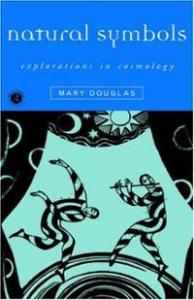
Anthropologist Mary Douglas published a book called Natural Symbols 45 years ago. It’s a gateway into thinking about how individuals encode their perceptions of reality through the complex cosmology of cultural symbols they live in — bodily or “natural” symbols in particular. The idea of the book was to develop a way of talking about how well the individual is integrated into society. Social integration is the idea of “order” that each of us carries with us everyday. In a nutshell, she was at play with the ideas of taboo and purity. These are at the root of everything. Either you love and embrace things or you hate and reject them. And you tend to learn these from society at large.
Ya’ think that’s some boring shit? Well, maybe, except when you actually try to understand what the hell is going on in the world today.
What we just went through last fall, standing in little pockets around the country in judgment of police in Ferguson, Missouri and Staten Island was an extreme case of how “natural symbols” work in real life. There was a huge amount of emotion attached to these two cases. I am not going to claim to know what the right answer was for the grand-juries in these no-win situations. What’s interesting, though, is that because these were cases of “white” cops violently ending the life of unarmed “black” men (do you see body symbolism at work here?), the whole nation was confronted with a stark reality. The brutality of public opinion was (and still is) on display for all to see.
I first read Natural Symbols in 1978. What I loved most about the book was Douglas’s reference to symbols as creating both “fear and emotional effervescence.” Each of us as individuals can have very strong opinions about a number of things — both good and bad opinions. But this world here, in 2015, is far different than Douglas’s world in the middle of the last century. We are individuals, true, but we now wield communications technologies that allow us to link our opinions and how we perceive symbols of all sorts into mass expressions of emotions. And it all gets quite interesting (and dangerous) when multiple mass expressions of emotion clash on screens everywhere all at once.
What happened in Paris with Charlie Hebdo in December is a case in point. The Western world’s response was to proclaim Je suis Charlie and then to march in mass demonstrations for free speech (not peace, mind you). Then Charlie Hebdo stepped forward again with more so-called satirical depictions of Muhammed and Islam. The Muslim world had a different response — at least part of the Muslim world. The issue of “free speech” was not that well appreciated by many. The point all along had been the extreme dismay and insult felt by many in the Islamic world that their religion would appear so trivialized by “the West” and that Islam and its prophet would be treated so blasphemously. Check this latest news out on Iran’s House of Cartoon just in case you’re wondering what I’m talking about. Both sides stepped out with extreme displays of moral judgement and hostility.
We seem to be getting really good nationally and globally at rapid fire mass judgment on everything from people being murdered to sporting events and celebrity excess — judgment without really knowing what actually happened or even what it means in the bigger puzzle of things. The media’s definitive conclusion about whether New England Patriots’ Tom Brady and Bill Belichick deflated game balls for the AFC Championship game is perfect example of this. No one knows what happened. When those two spoke to the media, they clearly didn’t know what to say. But by Tuesday morning the entire country had made up its mind about whether Brady and/or Belichick was “guilty of cheating.” As if that is some quite abnormal aspect of life. As if other teams don’t push the boundaries of sports themselves. As if you yourself don’t cheat at anything, ever. As if you know what actually happened was some profoundly immoral and evil thing.
All of these issues got played out on cable and broadcast TV, print, radio, and what I’m going to call here the Omniverse Internet Sphere of Confusion (its not just the Internet anymore) in such a way that the entire country, or even the entire world, seemed to feel it knew what the right answer was to each of these issues (and so many more). We become this mass judge and jury, take sides, spit, scratch, and claw sometimes before we have one single fact. Rumor, half-truth, and outright lies are all fair game in the decision making process for each of us. In fact, it is pretty clear to me that there was no “truth” to be had in any of the cases I’ve brought up. And the worst part of it is that I don’t think most people really want to wait on the truth anymore, or that very many people even believe there is such a thing as truth.
 Natural Symbols was published back in 1970. It’s virtue is that it seeks to define cultures by how symbols are used to integrate the individual into society by establishing a sense of order for each actor. Symbols have immense power, a kind of psychological valence. They are not about what is real, they are concerned with emotion — fear in all its guises and effervescence in all its magnificences. What I have called here the Omniverse Internet Sphere of Confusion (blogs, Facebook, Twitter, Instagram, YouTube, cable news, talk shows, video games, e-books, etc.) is nothing but symbols. But they are not simply “natural symbols” anymore. Compared to 1970 when all we had for the most part was our bodies, the Omniverse Internet Sphere of Confusion has become an infestation of infinite symbolic proportion completely having burst the bounds of the body. Each one of us operates on a dozen multiple tracks simultaneously, and most of those tracks are on screens and inside computers.
Natural Symbols was published back in 1970. It’s virtue is that it seeks to define cultures by how symbols are used to integrate the individual into society by establishing a sense of order for each actor. Symbols have immense power, a kind of psychological valence. They are not about what is real, they are concerned with emotion — fear in all its guises and effervescence in all its magnificences. What I have called here the Omniverse Internet Sphere of Confusion (blogs, Facebook, Twitter, Instagram, YouTube, cable news, talk shows, video games, e-books, etc.) is nothing but symbols. But they are not simply “natural symbols” anymore. Compared to 1970 when all we had for the most part was our bodies, the Omniverse Internet Sphere of Confusion has become an infestation of infinite symbolic proportion completely having burst the bounds of the body. Each one of us operates on a dozen multiple tracks simultaneously, and most of those tracks are on screens and inside computers.
We are multi-tasking like viruses in perfect growing conditions, defining the world through symbols (and memes) in terms of who we are and what we want to see as real, contributing to this monstrous thing we call the digital world, no longer with much concern at all for what is real and true. And it really is infinite.
All of this worries me a great deal. We seem to be losing any sense of humility that we might have learned in our childhoods — from our parents, teachers, and neighbors. There really was a time when most people understood that the big game of life was all about knowledge and working hard to understand this very complicated, overwhelming world.
In the 1960s, when everything from the Vietnam War and Civil Rights to Sex, Drugs, and Rock ‘n’ Roll made us giddy with opinion, the array of symbols we all operated from had limitations and we knew that. There was a sense of life being more or less under control and predictable. We had our ideas inside of us but we couldn’t really foist them on the world the way we can now. Today it’s so different. Somehow the vast, infinite sea of symbols we each grope through every time we log into this Omniverse cacophony of eye candy and electric sound makes us think we know what’s going on all the time.

In many ways we have become like David Bowie in The Man Who Fell to Earth. There’s too much for our minds to handle. Seriously, watch this clip from the movie (yeah, I know, it’s just symbolic, but still…)
“Get out of my mind. All of you!”
What’s scary is that we’re no longer simply dealing with unstoppable input, we are vomiting output and calling it identity in every way possible. The effect is to amplify and geometrically expand the emotional valence of all the symbols spewed forth. This is the hive mind at work. Some people think of the hive as a good thing. I don’t. It’s pure fiction. It is society as the emperor with no clothes. The hive mind is why so many people don’t think there’s such a thing as truth or reality, and why so many people don’t care about these things.
What do we do about this? I’m beginning to think it’s pretty simple. Get off the computer. Turn off the TV. Disengage from screens. I never thought I’d say that. I have loved the Apple Macintosh since I first bought one in 1988. I think iPhones, blogs, and iPads are pretty cool. But that electronic world they let you operate in has become toxic. People don’t communicate with “technology,” they infect each other with “memes.” You do it with Facebook “Likes,” twitter innuendo, blogs (like this one!), YouTube, and media PR events. It’s like we’re all taking part in a mass telepathy experiment that’s totally out of control. The only thing we’ve got going for ourselves is that we still have fingers that can turn things off. The question is whether we’ve gone too far and have lost control of those wonderful fingers of ours.
I’m not advocating complete isolation. Just measured control. We will go insane together otherwise. You don’t really know what’s going on. And you never will. Stop acting like you’re the smartest person in the room. Everyone who disagrees with you is not an asshole. There is truth out there, and good ideas to make a better world, but its probably not something you can put on a screen. Read books (on paper). Have family dinners and talk about the world. Ask questions. Take classes that make you write papers. Cook really good dinners. Don’t drink when you’re online. Don’t watch porn. What are you going to do about Climate Change? Think about what Love means to you. Think about what Love means to others. Ask college kids whether they believe in Truth. Are you afraid of death? Why are you afraid of death? When was the last time you cried and a screen wasn’t involved?
I’ll take my answers off the air. Seriously, make sure you watch the David Bowie clip!
It’s almost baseball season. See you out there.






Thank you for this essay, David. The last paragraph in particular sums up so much.
It feels like technology has created a world that is (for many) a mile wide and an inch deep. For years people have told me that writing long-form pieces is pointless under the assumption that “no one” will read to the end. I’ve seen memes generate far more activity on shared Facebook pages than even the most thoughtful and stimulating piece–if it requires effort.
The degree to which technology becomes braided ever deeper in each succeeding generation leaves me pessimistic that this will get any better in my lifetime. I hope I’m wrong.
Thanks Dan. Glad you get it. I think we’re talking about some serious shit here. You’re right about the question of the value of “long-form” writing. I am always quite fascinated when someone leaves me a comment like “Interesting piece. I didn’t finish it though. TMTR.” I had to Google that. “Too Much To Read.”
As always, technology revolutions swing both ways and have two-edges. I don’t question the value of the Internet as a massive resource base and communications tool. But people often get so half-cocked these days and are easily prone to premature criticism and hostile onanistic ejaculation onto the screen.
Hi David, thanks for your piece, which I read right through. I was looking for material on Mary Douglas for a talk I’m giving entitled: ‘Symbols, Rituals and Celebrations are the marks of human society; or, are they merely the bells and whistles of crass commercialism?’ You get the picture and probably where I am leaning.
Briefly, my theory is that symbols are the meeting point or stimulus for our conscious and unconscious minds; a symbol works to conscious awareness something that is only dimly grasped, if at all. I think poetry works this way and I love Emily Dickinson’s ‘Tell all the truth, but tell it slant . . .’
All the important things I know have a certain ‘slant-like’ quality (emerge from symbols?) when they break through, usually after years of digestion, into awareness and conviction and, with the talk in mind, into coherent expression.
I read Mary Douglas in the 70’s and knew it was an important book but was not sure why. As I get older I am revisiting a number of books like that.
With thanks and best wishes, Richard